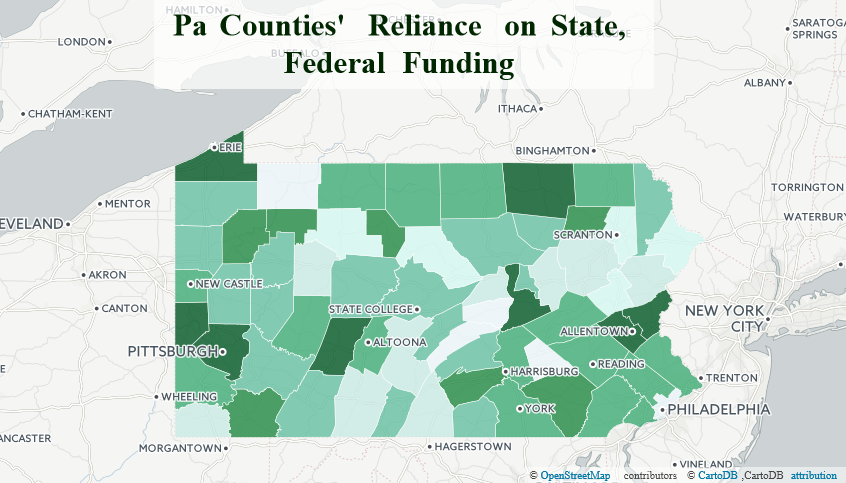Capitol recap: Can we predict vulnerability to the state budget impasse?

Counties rely on state and federal funding for as much as three-quarters of revenue.
Foster parents, homeless shelters, families facing eviction — they all depend, to varying degrees, on programs and funding bound to the state and federal government.
County governments coordinate some of those programs and pass through the money to social service agencies that run others.
At least 15 of 67 of the Commonwealth’s counties have stopped providing aid and services, or paying contractors to do so — or both — as the state budget impasse enters its fourth month, according to a report updated Monday by the County Commissioners Association of Pennsylvania.
The average municipality gets less than 15 percent of its revenue from state and federal government sources, according to Keystone Crossroads’ analysis of the Pennsylvania Department of Community & Economic Development’s statewide figures.
But some of its residents — particularly the most vulnerable — might depend on those county programs and services. So county governments — along with school districts — show the earliest effects of the state budget impasse.
State and federal funding comprise half of an average Pennsylvania county budgets, and as much as three-quarters in a given year, according to the Keystone Crossroads’ analysis.
But that number alone doesn’t illustrate how vulnerability to the budget stalemate varies across the state.
One major factor is how much cash a county has on hand. The bigger the cushion, the more unexpected costs a county can cover before borrowing money and incurring interest expenses (Northumberland recently became the seventh county to do that) or stopping provision of services or payments to providers (15 are at this point, as stated above).
Erie County is one that relies heavily on state and federal funding — yet indicates a much less dire situation than counties getting a lower percentage of revenue from higher levels of government. Those sources kick in a combined 65 percent of Erie’s revenue, according to the Keystone Crossroads’ analysis.
The Governmental Accounting Standards Board recommends governments keep enough money to pay operating expenses for two months without any income.
Erie goes beyond that, and so could cover the $12 million in typically state-funded human service costs that have come up since the budget stalemate started, according to Erie County Finance Director James Sparber.
Officials also arranged access to a line of credit with as little as two weeks’ notice. Sparber declined to detail potential borrowing costs, but acknowledged they’d go public if Erie does exercise that option.
Yet another factor: community partnerships.
Washington County contractor Southwest Behavioral Health Management, for example, has committed to providing up to $200,000 in services without payment, according to the CCAP report.
Such alliances also have been critical in Blair County, which gets 47 percent of revenue from the state and federal government, according to the Keystone Crossroads analysis of DCED stats.
“Everyone has really partnered well together on figuring out ways to continue services,” says Blair County Human Services Director Jim Hudack. “We’re hoping it doesn’t continue much longer because then it’s really going to start causing some issues. But we really have tried to look at which providers might need support, and intend to meet in the coming weeks to plan for the immediate future.”
All of that coordination takes time.
Asked whether it’s sacrificed any major initiatives, Hudack says he hopes the new alliances and strategies will bring benefits even after state lawmakers finally agree on a financial plan.
But Hudack also says it will take six weeks from whenever a deal’s struck in Harrisburg for the withheld funding to get to providers.
Already, Indiana County feared they’d have to stop sending stipends to foster parents – but can continue for now because they still have income and reimbursements coming in from the final quarter of the 2014-15 fiscal year ended June 30.
But York, Juniata, Mifflin and Luzerne coutnies are just some reporting they have no money left for emergency shelter, or asstiance with rent and utility bills. Evictions have happened in Luzerne County because of that.
But journalists at the Capitol say you’d never know it, with more than one reporter describing the impact of the budget standoff as a “quiet crisis.”
Editor’s note: This post has been updated to clarify municipal versus county budgets’ dependency on state and federal funding and update the status of Indiana County payments to foster/adoptive parents.
WHYY is your source for fact-based, in-depth journalism and information. As a nonprofit organization, we rely on financial support from readers like you. Please give today.



